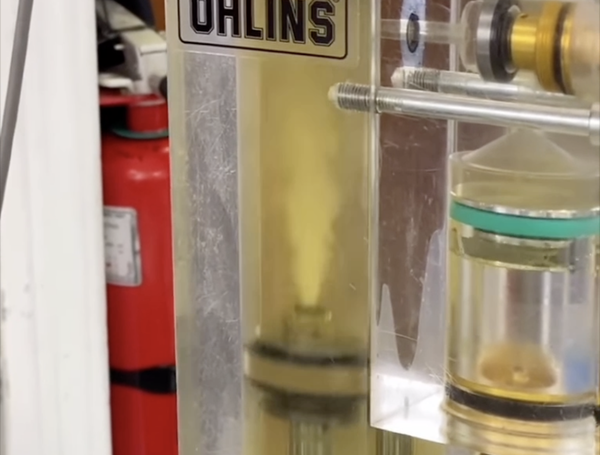Transparent Ohlins Shock Shows Perfectly What Cavitation is
Ohlins USA has created a very cool see through shock absorber which shows the mystical inner workings of your motorcycle suspension

Motorcycle suspension, and especially tuning it, is something of a dark art, which requires years of knowledge and practical experience to understand intimately.
One thing we never get to see, to the best of our knowledge anyway, is what is going on within your suspension while you are riding your motorcycle. With extreme pressures, heat and mechanical forces at work, a micro camera wouldn’t last a second in the environment, let alone be able to gather any quality footage.
The team from Ohlins USA have got around that problem though, by creating the working parts of a motorcycle shock absorber which features external parts which are made from clear plastic.
Not only does the nifty bit of kit show how the different elements of the shock absorber work together, it perfectly demonstrates how cavitation in the shock absorber occurs and the effect this has on the damping of the suspension.
Cavitation within suspension is when tiny bubbles of gas appear within the damping oil. It can occur when very fast pumping within the suspension creates a vacuum from which the bubbles are formed. To prevent this, a secondary cylinder (often seen on ‘piggyback’ style shock absorbers) is filled with pressurised hydrogen gas, which, via a secondary piston within the reservoir, exerts a constant pressure on the oil within the main shock absorber body, helping to reduce the production of the pesky bubbles.
The reason that cavitation is seen as a bad thing to have happening in your suspension is simple; gas can be compressed, but liquids, such as shock absorber oil cannot. In the same way that air in your brake lines will give you a spongy lever feel, cavitation in your shocks and forks will reduce the damping performance of the suspension and ruin the handling of the bike.

In the video you see here, filmed and posted by RevZilla, the Ohlins USA tech removes gas from the piggyback reservoir, lessening the oil pressure in the main shock absorber body as a result. Almost instantly you can see bubbles forming in the main shock body (top image) and also the smaller secondary reservoir above the nitrogen-filled chamber. After just a couple of strokes up and down on the rig, almost all of the oil looks to be boiling, as tiny bubbles are gas creep out from the liquid. Once this happens, the damping performance of the shock is reduced to almost nothing, and to rectify the matter the person adds the desired amount of nitrogen (he calls out “10 bar” which is a huge 145 PSI) back onto the reservoir - image directly above. Doing this almost instantly stabilises the system restoring the damping performance which would obviously have a massive positive effect on the way the bike would handle.
find all the latest motorcycle news on Visordown.com












